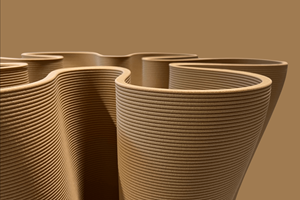Lewco supplies custom composites curing ovens for aerospace
Lewco Inc. recently supplied ovens to three customers ranging from a research laboratory to an aircraft manufacturer.
Composite curing oven. Photo Credit: Lewco Inc.
Lewco Inc., (Sandusky, Ohio, U.S.) a manufacturer of composites curing ovens, recently supplied ovens to three customers ranging from a research laboratory to an aircraft manufacturer. The ovens varied in size and capability, and they were custom made for each of the respective customers.
Lewco commissioned a large 500°F vacuum-assisted composite curing (VACC) oven to a national research laboratory, which researchers use to cure various composite parts. The electric walk in-oven features a rear mounted heater box with a heat capacity of 99 kilowatts. The oven is equipped with a 18,000 cubic feet per minute (CFM) high-efficiency circulation fan, which reportedly delivers dual airflow and provides uniform heat throughout the workspace. A temperature uniformity survey reported that the oven exceeded customer specifications of ±10°F by achieving better than ±5°F at maximum temperature.
Walk-in oven. Photo Credit: Lewco Inc.
In addition, Lewco delivered a 650°F enhanced duty electric batch oven to a world-class aircraft manufacturer. Lewco says this oven is unique as it is used for two applications: curing various aerospace composite parts and heating parts up to a maximum temperature of 650°F. The walk-in oven features a top-mounted heater box with 144-kilowatt heat capacity. The oven is equipped with a 22,000 CFM high-efficiency circulation fan that reportedly delivers dual airflow and provides uniform heat throughout the workspace. Due to some of the parts containing solvents, the oven is rated for NFPA 86, Class A and includes a 500 CFM exhaust fan. The oven is furnished with lanyards to hold the doors open while personnel enter the oven. An e-stop pull cord is included inside the oven to immediately power down the oven in case of entrapment. Included are four ½-inch national piper tapers (NPT) through wall vacuum ports with manual shut-off valves and dial pressure gauges on the exterior. All ports are connected to a 1-inch NPT common header pipe for a single connection to the customer’s vacuum source. Lewco says the customer required the oven to meet strict temperature uniformity requirements of ±10°F at an operating temperature of 650°F. A nine-point temperature uniformity test was conducted, and results were within the specifications.
Custom batch oven. Photo Credit: Lewco Inc.
Lastly, Lewco designed and manufactured an 800°F electrically heated walk-in oven that is used primarily for curing honeycomb composite structures; it also has capability for vacuum assisted composite curing. The enhanced duty batch oven features a top mounted heater-box with 180 kilowatts of heat capacity. The oven is equipped with a 24,000 CFM high-efficiency circulation fan that delivers horizontal airflow and provides uniform heat throughout the workspace. A variable speed drive is included on the exhaust fan for controlled cooling cycles and shorter purge time. The airflow volume of the oven is designed to meet strict temperature uniformity requirements. A nine-point temperature uniformity survey was conducted at 500°F and 750°F to ensure that customer requirements for their specific process have been met. Lewco says the temperature uniformity survey exceeded customer specifications of ±10°F by achieving better than ±5°F.
Related Content
Sulapac introduces Sulapac Flow 1.7 to replace PLA, ABS and PP in FDM, FGF
Available as filament and granules for extrusion, new wood composite matches properties yet is compostable, eliminates microplastics and reduces carbon footprint.
Read MoreReinforcing hollow, 3D printed parts with continuous fiber composites
Spanish startup Reinforce3D’s continuous fiber injection process (CFIP) involves injection of fibers and liquid resin into hollow parts made from any material. Potential applications include sporting goods, aerospace and automotive components, and more.
Read MorePlant tour: Airbus, Illescas, Spain
Airbus’ Illescas facility, featuring highly automated composites processes for the A350 lower wing cover and one-piece Section 19 fuselage barrels, works toward production ramp-ups and next-generation aircraft.
Read MoreIndustrializing additive manufacturing in the defense/aerospace sector
GA-ASI demonstrates a path forward for the use of additive technologies for composite tooling, flight-qualified parts.
Read MoreRead Next
Ceramic matrix composites: Faster, cheaper, higher temperature
New players proliferate, increasing CMC materials and manufacturing capacity, novel processes and automation to meet demand for higher part volumes and performance.
Read MoreScaling up, optimizing the flax fiber composite camper
Greenlander’s Sherpa RV cab, which is largely constructed from flax fiber/bio-epoxy sandwich panels, nears commercial production readiness and next-generation scale-up.
Read MoreNext-gen fan blades: Hybrid twin RTM, printed sensors, laser shock disassembly
MORPHO project demonstrates blade with 20% faster RTM cure cycle, uses AI-based monitoring for improved maintenance/life cycle management and proves laser shock disassembly for recycling.
Read More









